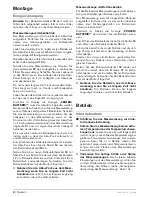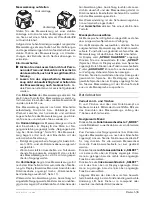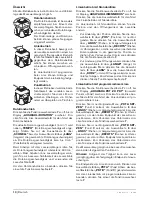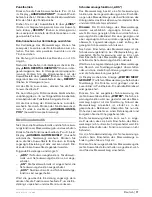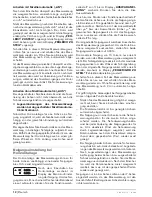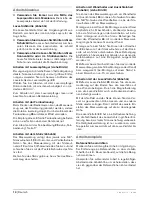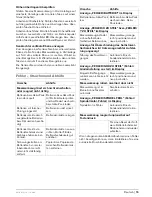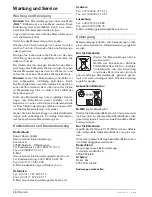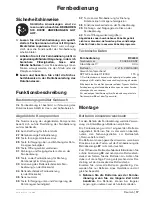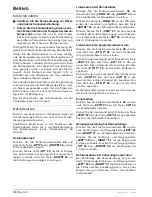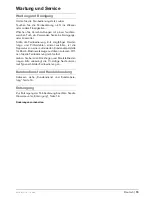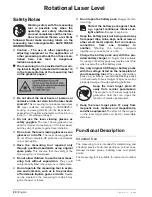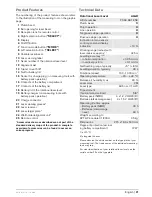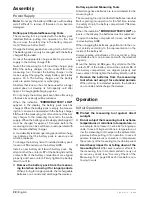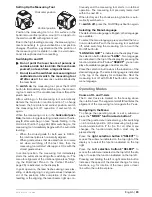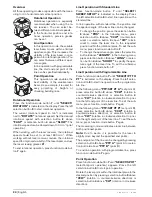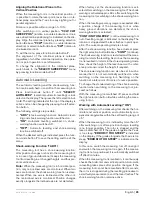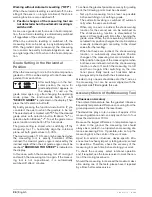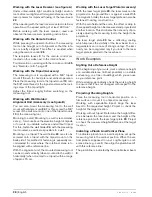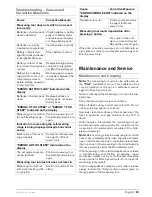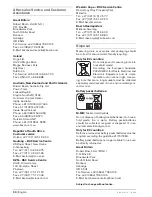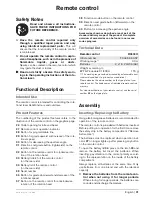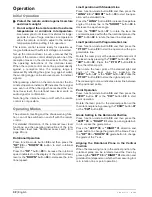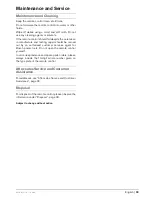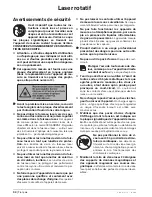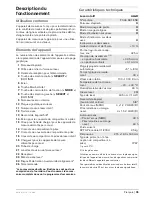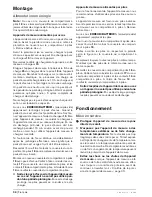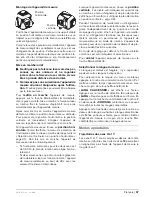
22
| English
2 610 A15 112 • 12.8.09
Assembly
Power Supply
Note:
Do not pry the battery lid
18
open with auxiliary
aids if difficult to remove. Otherwise it can become
damaged.
Battery-pack Operated Measuring Tools
The measuring tool is provided with the battery pack
installed. Before putting into operation for the first
time, remove the safety strip in the battery compart-
ment (“Remove before Use”).
Charge the battery pack before using for the first time.
The battery pack can only be charged with the battery
charger
19
provided.
Connect the appropriate charge cable for your mains
supply to the battery charger
19
.
Switch the measuring tool off. Insert the charger plug
20
of the battery charger into the socket
15
on the
measuring tool. Connect the battery charger to the
mains supply. Charging the empty battery pack takes
approx. 10 h. The battery charger and the battery
pack are protected against overcharging.
A battery that is new or has not been used for a longer
period does not develop its full capacity until after
approx. 5 charging/discharging cycles.
Do not charge the battery pack each time after using,
otherwise its capacity will be reduced.
When the indication
“ERROR/BATTERY LOW”
appears in the display, the battery pack must be
charged. When the battery pack is empty, the measur-
ing tool can also be operated with the battery charger
19
. Switch the measuring tool off and connect the bat-
tery charger to the measuring tool and to the mains
supply. When the battery pack is deeply discharged, it
must be charged for approx. 15 minutes before the
measuring tool can be switched on and operated with
the connected battery charger.
A considerably reduced operating period after charg-
ing indicates that the battery pack is used up and
must be replaced.
To change the battery lid with installed battery pack,
loosen nut
14
and remove the battery lid
18
.
Install a new battery lid
18
with battery pack. Pay
attention that the contacts
17
of the battery lid and the
contacts
16
of the battery compartment are aligned
properly and have contact. Firmly tighten the battery
lid with nut
14
.
f
Remove the battery pack from the measur-
ing tool when not using it for longer periods.
When storing for longer periods, the rechargeable
batteries can corrode and discharge themselves.
Battery-operated Measuring Tools
Alkali-manganese batteries are recommended for the
measuring tool.
The measuring tool is provided with batteries inserted.
Before putting into operation for the first time, remove
the safety strip in the battery compartment (“Remove
before Use”).
When the indication
“ERROR/BATTERY LOW”
ap-
pears in the display, the batteries must be replaced.
To open the battery compartment, loosen nut
14
and
remove battery lid
18
.
When changing the batteries, pay attention to the cor-
rect polarity according to the representation on the
inside of the battery lid.
Always replace all batteries at the same time. Only
use batteries from one brand and with the identical
capacity.
Mount the battery lid
18
again. Pay attention that the
contacts
17
of the battery lid and the contacts
16
of
the battery compartment are aligned properly and
have contact. Firmly tighten the battery lid with nut
14
.
f
Remove the batteries from the measuring
tool when not using it for extended periods.
When storing for extended periods, the batteries
can corrode and discharge themselves.
Operation
Initial Operation
f
Protect the measuring tool against direct
sunlight.
f
Do not subject the measuring tool to extreme
temperatures or variations in temperature.
As
an example, do not leave it in vehicles for longer pe-
riods. In case of large variations in temperature, al-
low the measuring tool to adjust to the ambient tem-
perature before putting it into operation. In case of
extreme temperatures or variations in temperature,
the accuracy of the measuring tool can be impaired.
f
Avoid heavy impact to or falling down of the
measuring tool.
After severe exterior effects to
the measuring tool, it is recommended to carry out
an accuracy check (see “Accuracy Check of the
Measuring Tool”, page 26) each time before con-
tinuing to work.
OBJ_BUCH-971-001.book Page 22 Wednesday, August 12, 2009 8:46 AM
Summary of Contents for AL-Series
Page 2: ...2 2 610 A15 112 12 8 09 6 5 3 4 3 8 7 2 2 1 9 12 13 16 17 18 14 15 11 10 13 ALGR...
Page 3: ...3 2 610 A15 112 12 8 09 19 21 22 23 24 20 25 B A...
Page 4: ...4 2 610 A15 112 12 8 09 28 27 26 29 30 31 32 33 34 35 37 36 38 39 40 RC400X...
Page 155: ...E 155 2 610 A15 112 12 8 09 f f 10 f f 2 IEC 60825 1 f f UV f f f f f f f CST berger 23 f 23...
Page 158: ...158 E 2 610 A15 112 12 8 09 f f f 163 24 f f ON OFF 6 9 1 5 162 0 00 30 s 5 161 60 s ON OFF 6...
Page 163: ...E 163 2 610 A15 112 12 8 09 30 s 12 20 m 100 m 20 m 20 m Service Bosch 30 m 30 m 0 00 I 30 m...
Page 165: ...E 165 2 610 A15 112 12 8 09 5 8 13 13 5 8 B 24 5 8 13 24 24 15 cm 23 23 23 1 9...
Page 240: ...240 2 610 A15 112 12 8 09 f f 10 f f 2 IEC 60825 1 f f f f f f f f f CST berger 23 f 23...
Page 243: ...243 2 610 A15 112 12 8 09 f f f 248 24 f f 6 9 1 5 247 0 00 30 5 245 60 6...
Page 255: ...255 2 610 A15 112 12 8 09 Bosch 10 oe e e e oe e e e 251 252...
Page 256: ...256 2 610 A15 112 12 8 09 f f 10 f f 2 IEC 60825 1 f f f f f f f f f CST berger 23 f 23...
Page 270: ...270 2 610 A15 112 12 8 09 Bosch 10 C a a c ep i i i C a a c ep i i i 267 267...
Page 285: ...285 2 610 A15 112 12 8 09 f f 10 f f 2 IEC 60825 1 f f f f f f f f f CST berger 23 f 23...
Page 294: ...294 2 610 A15 112 12 8 09 22 600 min 1 25 3 25 297 5 8 13 13 24 5 8 13 24 24 15 cm 23 23 23...

